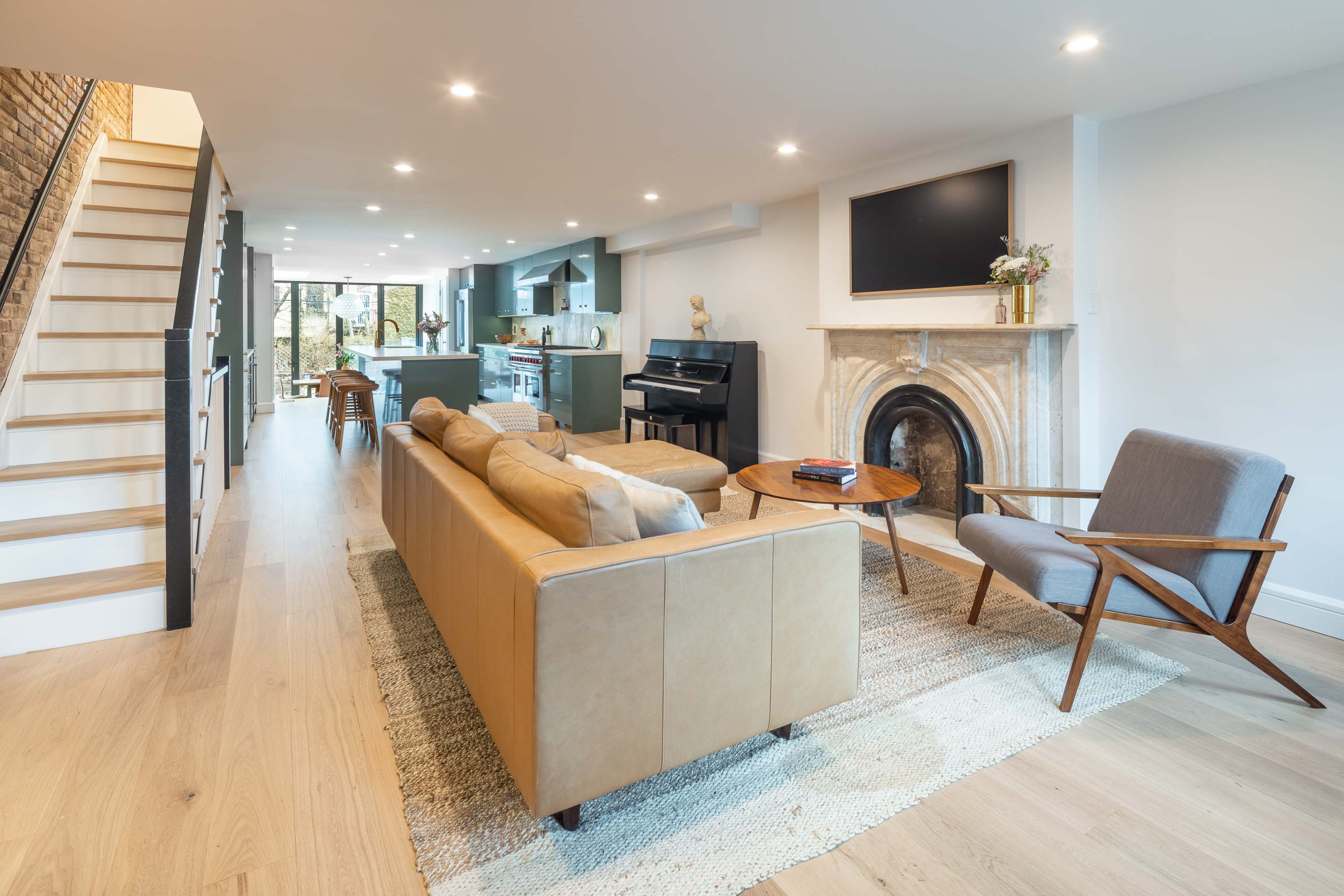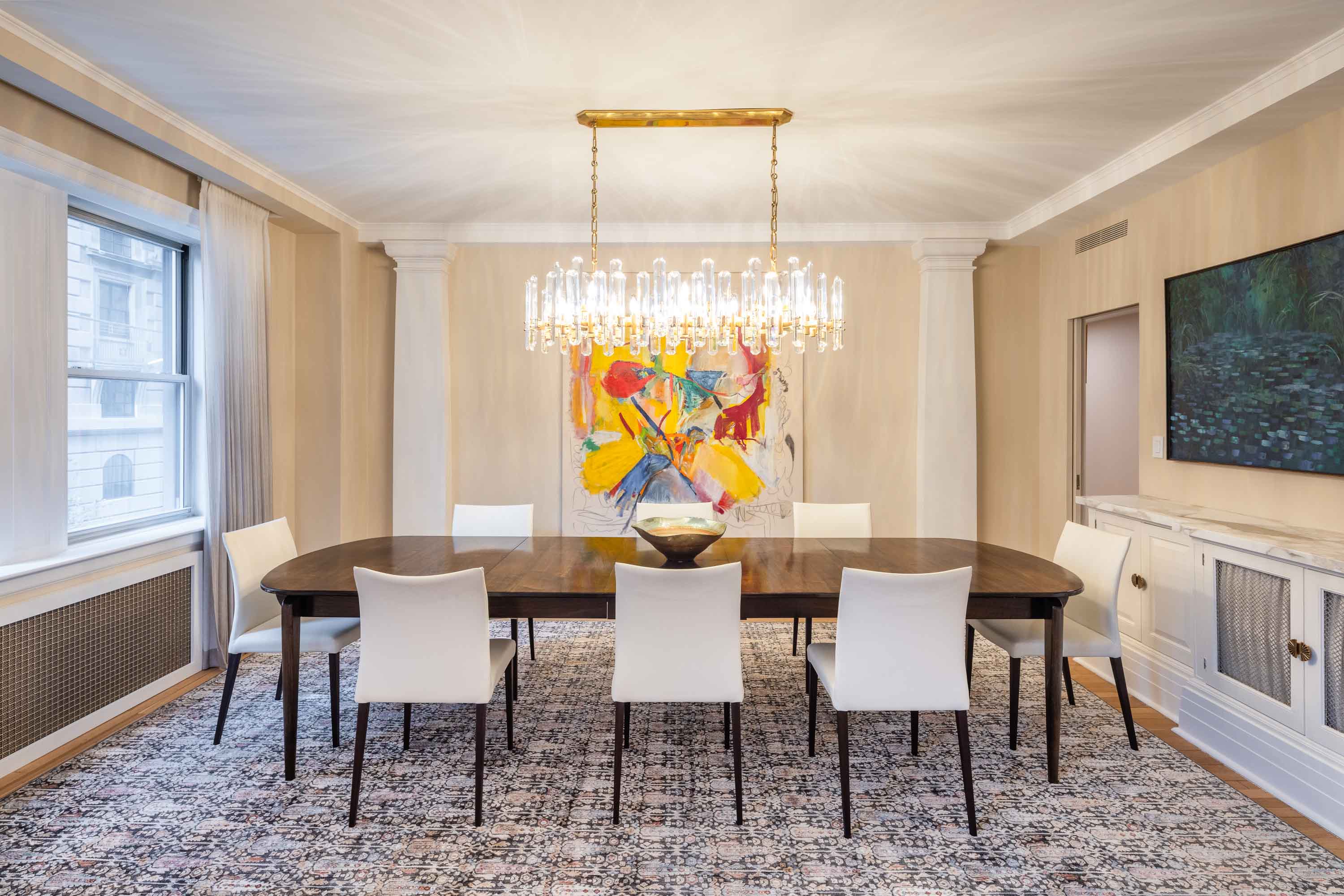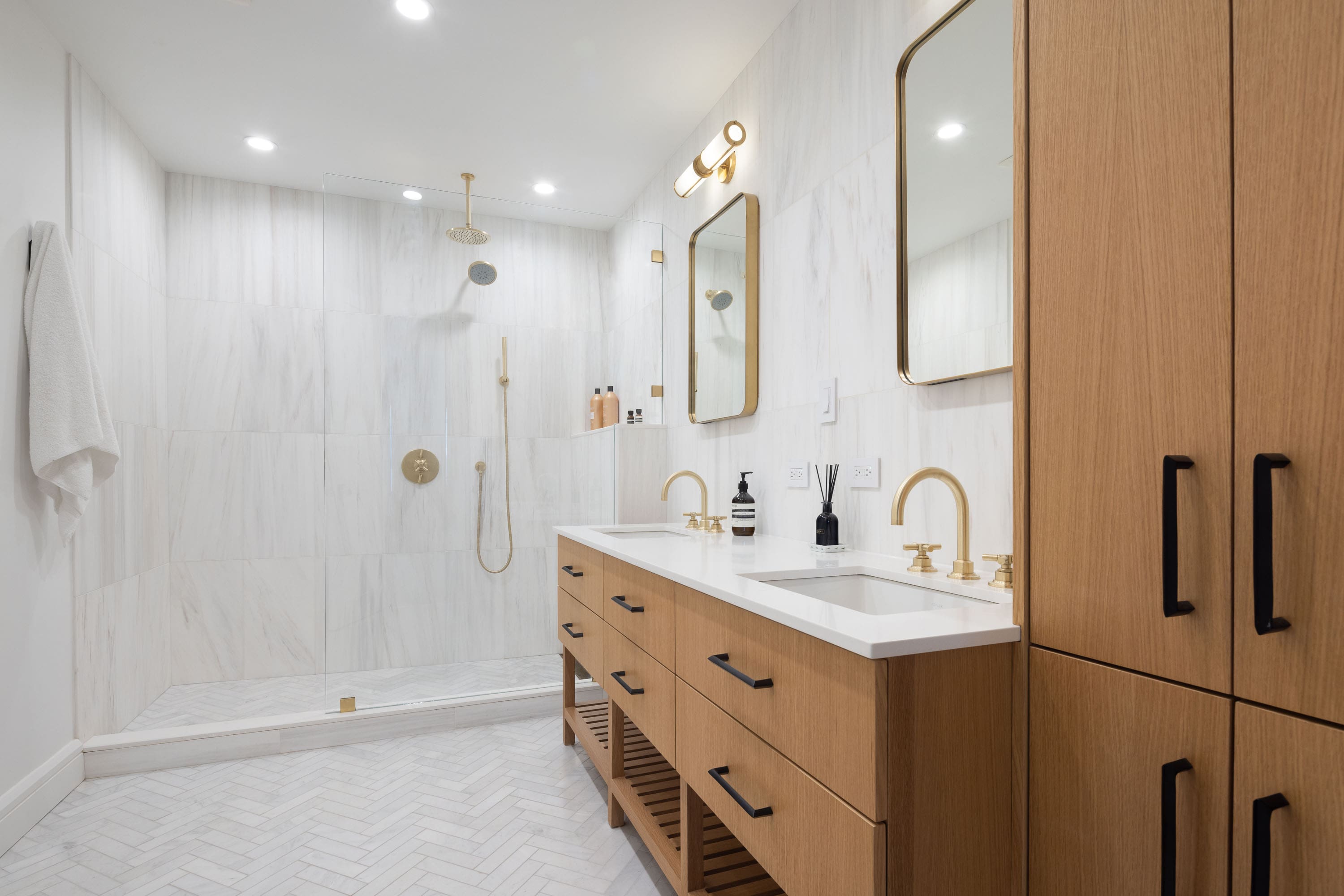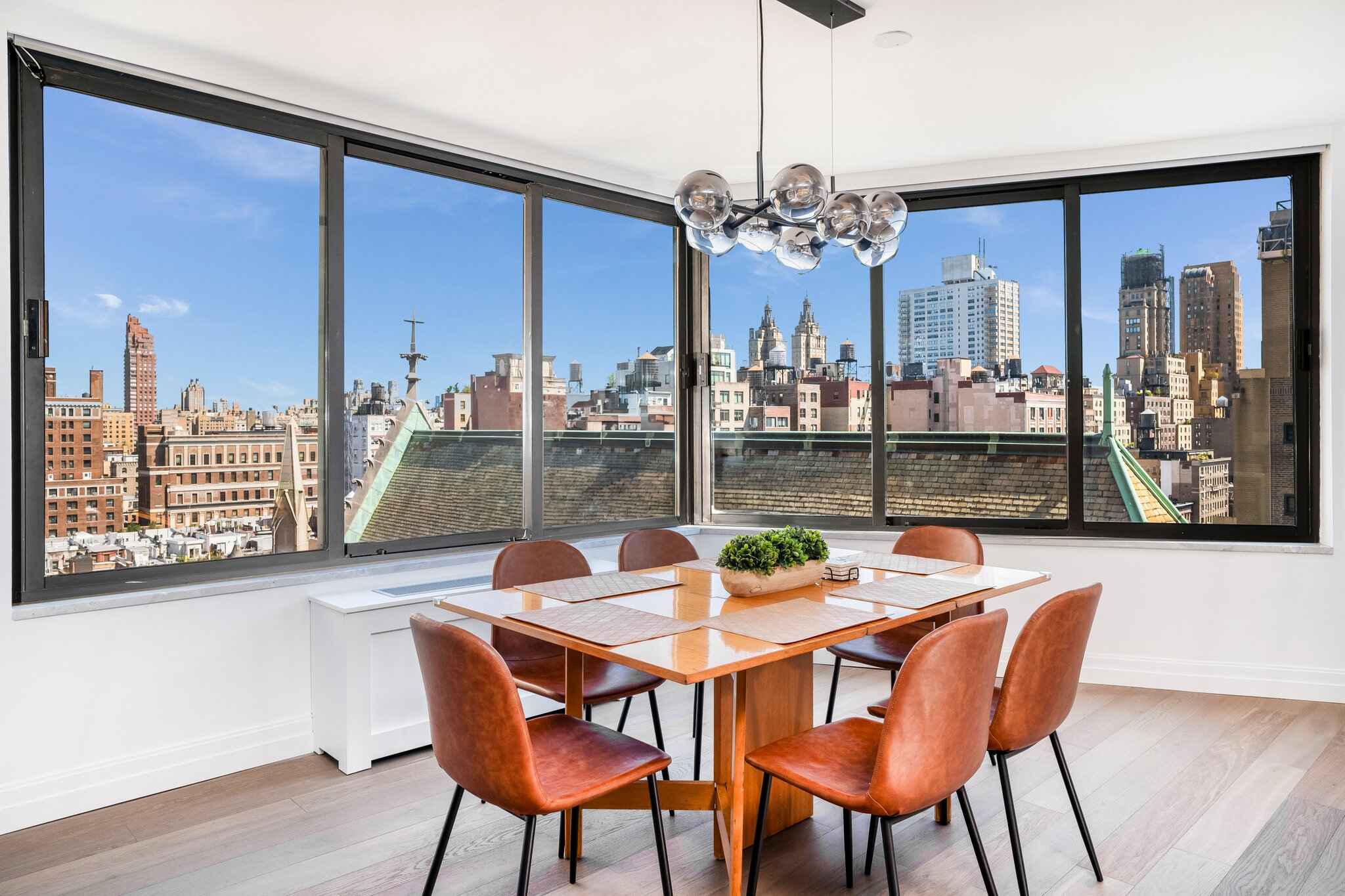Leveling Floors During A NYC Renovation: Design & Cost Implications
Hidden floor issues often surface mid-renovation, but a design build partner ensures problems are solved before they become expensive delays.
October 1, 2025
|

Leveling Floors During A NYC Renovation: Design & Cost Implications
Uneven floors are practically guaranteed in NYC’s older homes—but understanding the trade-offs and planning ahead can turn this challenge into a seamless part of your renovation.
TABLE OF CONTENTS
- What Does Leveling Entail?
- Critical Elements To Consider When Leveling Floors
- When Floors Aren’t Leveled
- Managing Expectations Through Design-Build
In New York City’s older housing stock—whether cast-iron lofts in SoHo, pre-war co-ops along Central Park West, or historic townhouses in Brooklyn—unlevel floors are practically a given. Many of these buildings were framed with long-span wood joists that have bowed or settled over decades, leaving floors that visibly slope toward the center of a room or away from stairwells.
For most homeowners, slanted floors are more than a quirky character flaw, they’re a structural condition that carries real design and functional consequences. At Gallery, we approach floor leveling not as an isolated fix, but as part of the larger design-build process. That means weighing the trade-offs (while communicating them proactively), managing the structural work, and integrating the solution seamlessly into the rest of your full home renovation.

[#1]What Does Leveling Entail?[#1]
In a brownstone and loft spaces, making a floor level again usually means addressing the structure beneath, not just smoothing the surface above. This allows us to gradually bring the floor into alignment while reinforcing the structure.
Because every joist has likely settled differently, leveling becomes a tailored process, with each room requiring evaluation, adjustment, and integration into the design plan. When done properly, your restored flooring not only creates a flat walking surface but also strengthens the home for decades to come.
[#2]Critical Elements To Consider When Leveling Floors[#2]
Ironically, correcting an uneven floor can introduce new irregularities elsewhere in your home. That’s why we evaluate leveling within the broader context of a renovation, always accounting for potential ripple effects.
Stairs & Entryways
Building code allows stair risers only within a specific range (7¼ to 8¼ inches). Leveling can alter those heights, requiring reconfigured staircases or rebuilt steps. Entry thresholds may also shift, impacting accessibility and flow between rooms.
Ceiling Heights
Raising a floor inevitably reduces ceiling height. In apartments with already limited clearance, this trade-off must be weighed carefully, especially for tall clients or spaces like kitchens where ceiling lines are visually important.
Kitchens & Fixtures
Floor adjustments can throw off sink heights, counter alignment, or window placement. Our design team accounts for these sneaky shifts early so cabinetry and millwork remain both functional and visually consistent.
Excavation & Underpinning
In townhouse basements, one option to gain headroom is to dig deeper. But doing so requires underpinning—reinforcing the existing foundation before excavation. This is a complex, engineering-heavy process with high costs (often $200,000–$300,000+) and strict oversight from engineers, boards, and sometimes landmarks authorities. In certain instances, underpinning can be the right move when looking to add valuable living space, but it is never a casual decision.

[#3]When Floors Aren’t Leveled[#3]
Sometimes, clients opt not to level floors—either for cost reasons or because the slope is relatively minor. When that’s the case, we have the responsibility to set clear expectations and design accordingly. Here’s how Gallery accommodates, when necessary:
Doors And Undercuts
Doors on uneven floors may not clear rugs or may require undercuts. While a modest undercut (½ inch) can be practical, deeper cuts (¾ inch) compromise privacy and soundproofing. We specify these dimensions during floor plan development so there are no surprises.
Baseboards & Trim
To hide gaps, we may design taller baseboards that can be scribed to the floor. In modern interiors, where shoe molding isn’t desirable, this detail becomes especially important.
Furniture & Millwork
Freestanding pieces may wobble, while built-ins must be customized to account for uneven surfaces. Thanks to proper-planning from our architectural and design teams, our millworkers fabricate cabinetry and trim to fit these conditions precisely.
[#4]Managing Expectations Through Design-Build[#4]
Few challenges highlight the value of a design-build firm more clearly than uneven floors. Our architects, engineers, and construction team evaluate conditions together, balancing aesthetics, cost, and practicality. If leveling is recommended, we handle the structural work seamlessly within the renovation scope.
Just as importantly, we communicate these implications early. During walkthroughs, we physically point out slope conditions to clients, discuss options, and document final decisions. This proactive approach prevents surprises and ensures every detail—from stair comfort to soundproofing—is accounted for.

Final Considerations When Leveling Up Your Home
Leveling floors is one of those unforeseen renovation decisions that quietly shapes everything else, from how doors swing to how cabinetry sits. With so many older buildings in NYC, these uneven conditions have become second-nature within our planning process. Whether you decide to level or not, the key is understanding the trade-offs, planning accordingly, and trusting a partner who can handle both the structural and design implications as part of a comprehensive renovation.
Considering a townhouse or apartment renovation in New York City that may require leveling your floors? Learn how a fully integrated design-build firm like Gallery KBNY streamlines the complex process—from feasibility to board approvals to final finishes. View our portfolio of NYC renovations, learn more about our full-service process, or contact us to discover why our client-first and all-inclusive approach is the smartest way to navigate NYC’s most intricate types of renovations.

.png)
.png)


-min.jpg)


.jpg)

%20(2).jpg)


.jpg)
%20Gallery%20KBNY.JPG)


